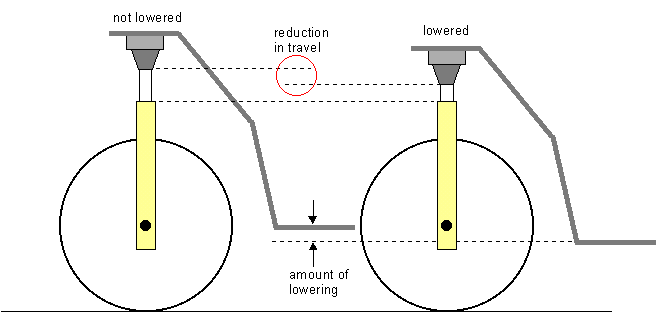The primary disadvantage of using shorter springs to lower a car is that the suspension travel
is reduced. This is shown in Figure 1 above which displays a schematic of a car with front
strut suspension. Caster is set to zero to aid visualization. Note the reduction in suspension
travel that occurs when the car is lowered (shown by the red circle). This happens because
using a shorter spring brings the upper strut bearing (or camber plate) closer to the top of the
strut housing. This pushes the bump stop down and since travel is defined as the distance between
the bump stop and the top of the strut housing, travel is reduced. The only way around this is
to either use a shortened strut housing or to cut the bump stop. Shorter strut housings (and
correspondingly shorter struts) have been available for some cars in the past, but are not
available for BMW's to my knowledge. Cutting the bump stops is therefore the only alternative.
|
|
Cutting the bump stops may seem like a bad idea at first. After all, the bump stop is meant
to cushion the impact when the limit of travel is reached due to a particularly large bump.
But the fact is, most of the shorter springs that people install to lower their cars are
also stiffer. Thus although a lower car has less suspension travel, it also needs less
travel since a stiffer spring does not compress as far as a softer spring under identical
conditions. So if you can achieve the proper combination of travel and spring rate, then
your suspension is less likely to even reach the bump stops.
|
|
The interaction of the bump stop with the spring is part of a system analysis that will require
a separate write up. Suffice it to say that the degree to which you can trim your bump stops
is linked to how stiff your springs are. If you lower your car and do not trim the bump stops
sufficiently then you will be contacting the stops frequently which will add a highly progressive
effect to your overall spring rate. On the other hand, if you trim the stops too much then,
when your suspension does hit the stops, the impact will be rather severe.
Ultimately, matching bump stops to spring rate and ride height is a trial-and-error process.
|

